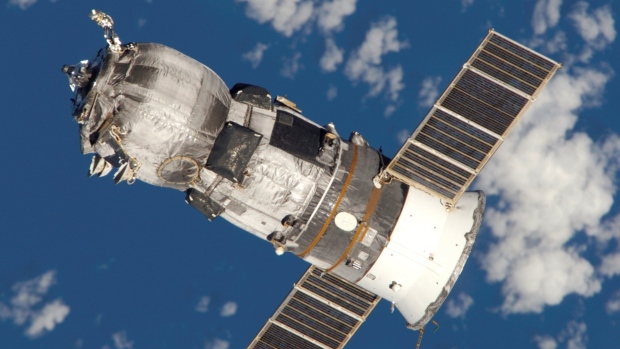Flight controllers were unable to receive data from the Russian spacecraft, which had entered the wrong orbit on Tuesday [April 28, 2015]. (NASA)
It’s impossible to predict where an unmanned, out-of-control Russian spacecraft could crash into Earth and debris the size of soccer balls could rain down as the spaceship re-enters the atmosphere.
‘Chicken Little’ was right! The Progress M-27M cargo spacecraft, which was ferrying supplies to the International Space Station, is spiralling back to Earth after communications with it were lost earlier this week. “It has started descending. It has nowhere else to go,” an official familiar with the situation told AFP news agency on condition of anonymity, speaking ahead of an official Russian space agency statement.
“It is clear that absolutely uncontrollable reactions have begun.” Astrophysicist and associate professor at the Australian National University Charley Lineweaver said if the spacecraft continued on its current orbit it would “come down between May 5 and May 7″.
“Right now we don’t have any idea [where it will land] except that it will be at between plus-50 and minus-50 degrees Alatitude on the Earth’s surface and … that is something like two-thirds of the Earth,” Dr Lineweaver said.
“We can’t predict what the pieces will be like when they come down. “If it comes down at a very narrow angle and burns up it, could burn up completely. “If it comes down more straight and bigger pieces are left, then big pieces the size of your head or a soccer ball will come down and a debris field will be created.
“The question is how dangerous is it? The answer is we are not quite sure.” But Dr Lineweaver said the chances of it hitting a city or person were extremely low. “The surface of the Earth is much bigger than the heads of 7 billion people by probably a factor of a million or a billion,” he said. “The probability of it hitting a person, or a car, or even a city is very tiny.”
Attempts to contact shuttle unsuccessful
An official said the descent likely marked the end of the spacecraft’s mission, although the Russian authorities will attempt to contact it again. Problems began when communication with the spacecraft was lost shortly after it successfully launched on Tuesday.
The loss of the Progress supply ship would be the latest embarrassment for Russia’s space program, that has been recently hit by a series of mishaps. The ship had been scheduled to dock with the ISS, where the international crew of six people is awaiting the cargo, today.
In releasing footage from the craft, NASA said Russian flight controllers were trying to troubleshoot “issues”. “The spacecraft made another pass over Russian ground stations and continued to experience telemetry problems regarding the deployment of navigational antennas and the pressurisation of the manifolds,” it said.
Astronauts have plenty of provisions
Russia’s deputy prime minister in charge of the aerospace industry, Dmitry Rogozin, who is currently in China, said he was in constant touch with the space agency. “We’re all worrying about our cargo spacecraft,” he said on Twitter.
NASA said none of the equipment on board was critical for the US section of the ISS, and that the astronauts had plenty of provisions, enough to last for months. The Progress was carrying “1,940 pounds [880 kilos] of propellant, 110 pounds of oxygen, 926 pounds of water, and 3,128 pounds of spare parts, supplies and scientific experiment hardware,” NASA said.
The next delivery to the ISS is planned by SpaceX‘s Dragon cargo ship on June 19. The Russian space program is renowned for having sent the first man into space in 1961 and launching the first Sputnik satellite four years earlier, and remains a major source of national pride.
But more recently it has endured a series of setbacks, notably losing expensive satellites and a similar Progress supply ship in 2011. Shortly after launch, the vessel crashed into Siberia, marking one of Russia’s biggest space setbacks. ABC/AFP Source: ABC News
Skylab was a US space station launched by NASA in 1973, and was manned by teams of astronauts as it orbited the earth. It collected vast amounts of data and images before being abandoned in space in 1974. In 1979, NASA realised that Skylab was starting to break up and would re-enter the earth atmosphere, but they were unable to control Skylab’s path, nor could they predict exactly where the pieces might land.
As NASA, and the world’s media, tracked Skylab’s progress in early July 1979, it seemed it could end up anywhere. In the early hours of the 12th of July, 1979, Skylab crashed on WA’s south east coast, scattering debris across the Nullarbor and the eastern goldfields and causing a worldwide sensation.
NASA officials arrived in Esperance to check out the wreckage. Every local that brought a piece of Skylab to the shire offices to be verified was given a plaque. But it was a US newspaper, the San Francisco Examiner, who turned the hunt for souvenirs into a frenzy when they offered $10,000 dollars to the first person to arrive at their office with an authentic piece of Skylab – the winner had just 72 hours to get to America. The prize was claimed by 17 year old Stan Thorton from Esperance.
These days, Skylab is a source of pride to the people of Esperance and the Nullarbor, who remember the lights, the sonic boom and the fuss that followed. The skylab crash put Esperance on the map, but it didn’t stop the shire council having a light hearted dig at NASA for scatter space junk over the town, sending them a $400 fine for littering, which they never paid.
Today, Skylab is celebrated by the locals with a large display of wreckage, photographs and Skylab models at the local museum. You can hear the story of skylab, told through archival reports and locals, in the audio link on the left. Source: Space and Astronomy news





